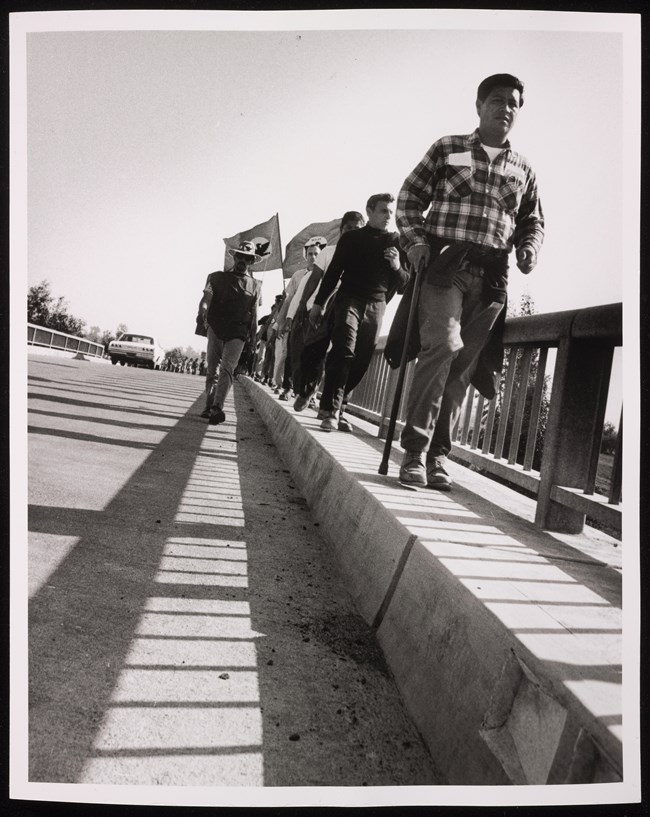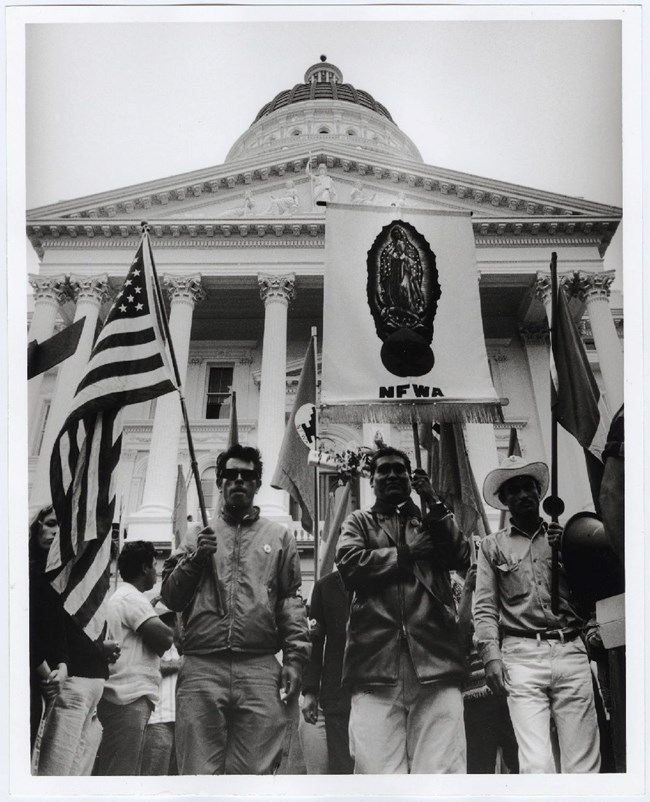Part of a series of articles titled The Road to Sacramento: Marching for Justice in the Fields.
Article
Mobilizing Support for La Causa

Jon Lewis Photographs of the United Farm Workers Movement. Yale Collection of Western Americana, Beinecke Rare Book and Manuscript Library.
After six months of picketing and protest, the Delano Grape strikers remained out of work with no area grower agreeing to a contract. The situation demanded bold action. This article explores the decision to organize a historic march to the state capital in Sacramento and examines the planning, preparation, and execution of the historic pilgrimage.
By early February 1966, the Delano Grape Strike had reached an impasse.
A small group of picketers remained active after the harvest ended, but the growers could count on enough workers breaking the strike to complete the pruning of the vines in January and February. Faced with waning enthusiasm for the strike, the National Farm Worker Association (NFWA) leadership knew they would have to act: once the pruning of the grapes ended in late February, the labor demands of the vineyards were minimal, diminishing the impact of the picket lines. Spring was typically a quiet time for workers around Delano, as the need for grape workers did not pick up again until mid-May. But the spring of 1966 was to be different. It was to be a time of action.
In early February 1966, the leadership of the NFWA, including Cesar Chavez, Dolores Huerta, Roberto Bustos, Marshall Ganz, Jim Drake, Luis Valdez, and Tony Mendez, met near Santa Barbara to plan out the next steps in the ongoing strike. There, Chavez proposed a farm worker march to revitalize the movement. The civil rights march from Selma, Alabama to Montgomery the year before had demonstrated that a well-organized, highly publicized march could galvanize supporters and bring pressure to bear on lawmakers. The farmworker march also reflected the Civil Rights Movement’s strategy of nonviolence; early in the grape strike, the NFWA brought organizers from the Student Nonviolent Coordinating Committee (SNCC) and the Congress of Racial Equality (CORE) to Delano to instruct farmworkers in the tactics and strategies of nonviolent resistance. Just as the civil rights activists marched to demand voting rights for Black southerners, the farmworkers would march to demand justice in the form of labor legislation. But the NFWA march had important religious and cultural meanings as well.
The NFWA outlined the purpose of the march in a document called, The Plan of Delano (El Plan de Delano). Written by Valdez and Chavez, the statement outlined the movement’s actions and objectives. It was modeled after Emiliano Zapata’s Plan de Ayala, which laid the framework for the southern insurgency during the Mexican Revolution. The preamble to The Plan of Delano called for the liberation of farmworkers, “seeking social justice in farm labor with those reforms that they believe necessary for their well-being as workers in the United States.” The Plan explained that this was not just a march, but a pilgrimage--peregrinación--an act of Christian penance to symbolize the suffering they would endure to bring justice to the fields. It declared: “This is the beginning of a social movement in fact and not in pronouncements. We seek our basic, God-given rights as human beings.”

Jon Lewis Photographs of the United Farm Workers Movement. Yale Collection of Western Americana, Beinecke Rare Book and Manuscript Library.
Marching for Justice in the Fields
The march coincided with Lent, drawing on the theme of penance and sacrifice in the Roman Catholic tradition, and was timed to conclude on Easter Sunday, a powerful metaphor for the farmworkers’ aspirations for redemption.
The organizers timed the march to begin the day after the Senate Subcommittee on Migratory Labor, which was led by Senator Robert Kennedy, wrapped up its hearings in Delano. Several members of the national press remained to cover the beginning of the march, getting the pilgrimage off to a well-publicized start. From there, the marchers would proceed 280 miles north to conclude their march at the state capitol building in Sacramento, where they hoped to have an audience with Governor Pat Brown. The march coincided with Lent, drawing on the theme of penance and sacrifice in the Roman Catholic tradition, and was timed to conclude on Easter Sunday, a powerful metaphor for the farmworkers’ aspirations for redemption.
As the farmworkers made their way through the Central Valley, they carried a banner with the image of Our Lady of Guadalupe, the patron saint of Mexico. The marchers also carried the American flag and the flag of the NFWA, a black eagle on a field of red. The marchers, ranging from teenagers to elderly veterans of the field, bore signs proclaiming their boycott against Schenley grapes, enlivening the backroads with music and shouts of “¡Viva Huelga!” and “¡Viva Chávez!"
Each morning the march began with a mass. These services were offered by local clergy as well as priests and other officiants visiting to show support for the farmworkers. Some days, especially early on, about 50 or 60 men and women set out for the day's journey. Later, as the group neared Sacramento, hundreds and even thousands took part.
Along the way, the march passed through over fifty towns and cities. The marchers stopped for the evenings in communities like Visalia and Madera, where gatherings of hundreds, and sometimes thousands, of supporters received them. An advance team of farm workers and organizers worked with local farmworker committees to handle the logistics of greeting the march, feeding and housing the footsore marchers, organizing the rally, and holding Catholic mass. Every night, Luis Valdez would read The Plan of Delano, and local farmworkers would add their names to the proclamation. (To hear Luis Valdez reading the plan in 1966 during the march, listen here). This was followed by singing and lively entertainment from El Teatro Campesino, a theatre troupe made of farmworkers, who brought their struggle to the stage with comedic parodies of the farmworker struggle.
Bibliography
Araiza, Lauren. To March for Others: The Black Freedom Struggle and the United Farm Workers. First ed. Politics and Culture in Modern America. Philadelphia: University of Pennsylvania Press, 2014.
Bardacke, Frank. Trampling out the Vintage : Cesar Chavez and the Two Souls of the United Farm Workers. New York: Verso, 2011.
Jenkins, J. Craig. The Politics of Insurgency: The Farm Worker Movement in the 1960s. New York: Columbia University Press, 1985.
Levy, Jacques E., and Chavez, Cesar. Cesar Chavez: Autobiography of La Causa. 1st ed. New York: Norton, 1975.
Shaw, Randy. Beyond the Fields: Cesar Chavez, the UFW, and the Struggle for Justice in the 21st Century. Berkeley: University of California Press, 2008.
Last updated: March 20, 2025
